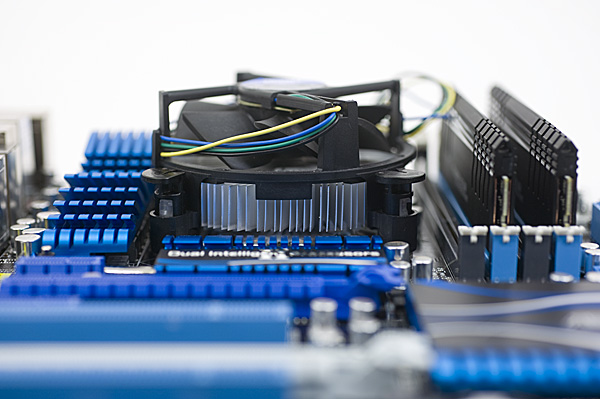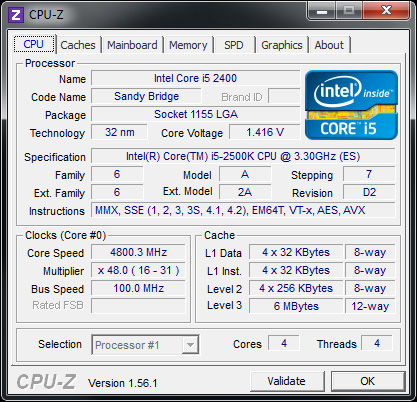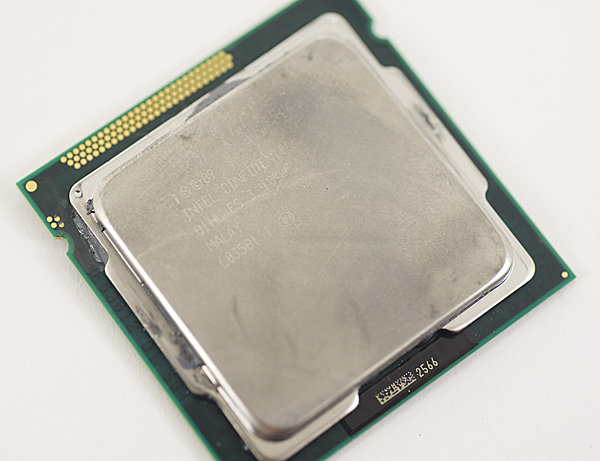The Sandy Bridge Review: Intel Core i7-2600K, i5-2500K and Core i3-2100 Tested
by Anand Lal Shimpi on January 3, 2011 12:01 AM ESTOverclocking, the K-Series and What You’ll Want to Buy
If you haven’t noticed, the computing world is becoming more integrated. We review highly integrated SoCs in our smartphone coverage, and even on the desktop we’re seeing movement towards beefy SoCs. AMD pioneered the integrated memory controller on desktop PCs, Intel followed suit and with Lynnfield brought a PCIe controller on-die as well. Sandy Bridge takes the next logical step and brings a GPU on-die, a move matched by AMD with Brazos and Llano this year.
In the spirit of integration, Intel made one more change this round: the 6-series chipsets integrate the clock generator. What once was a component on the motherboard, the PLL is now on the 6-series chipset die. The integrated PLL feeds a source clock to everything from the SATA and PCIe controllers to the SNB CPU itself. With many components driven off of this one clock, Intel has locked it down pretty tight.
With Nehalem and Westmere, to overclock you simply adjusted the BCLK from 133MHz to whatever speed you wanted and sometimes toyed with multipliers to arrive at a happy end result. With Sandy Bridge, the BCLK generated on the 6-series PCH is at 100MHz by default and honestly won’t go much higher than that.
While I’ve heard reports of getting as high as 115MHz, I’d view 103—105MHz as the upper limit for what you’re going to get out of BCLK overclocking. In other words: next to nothing. A 105MHz BCLK overclock on a Core i7-2600 will take you from a stock speed of 3.4GHz to a whopping 3.57GHz. The form of overclocking we’ve been using for the past decade is effectively dead on Sandy Bridge.
Years ago, before the Pentium II, we didn’t rely on BCLK (or back then it was just FSB or bus overclocking) to overclock. Back then, if we wanted a faster CPU we’d just increase the clock multiplier. Intel has dabbled in offering multiplier unlocked parts for overclockers, we saw this last year with the Core i7 875K for example. With Sandy Bridge, those unlocked parts are going to be a lot more important to overclockers.
It works like this. If you have a part that does not support Turbo (e.g. Core i3-2100 series), then your CPU is completely clock locked. You can’t overclock it at all, have fun at your stock frequency. This is good news for AMD as it makes AMD even more attractive at those price points.
If you have a part that does support turbo (e.g. Core i5-2400), then you have what’s called a “limited unlocked” core—in other words you can overclock a little bit. These parts are limited to an overclock of 4 processor bins above and beyond the highest turbo frequency. Confused yet? This chart may help:
In this case we’re looking at a Core i5-2500, which runs at 3.3GHz by default. When a single core is active, the chip can turbo up to 3.7GHz. If you want, you can change that turbo state to go as high as 4.1GHz (if your CPU and cooling can keep up).
Overclocking these limited unlocked chips relies entirely on turbo however. In the case above, the fastest your chip will run is 4.1GHz but with only one core active. If you have four cores active the fastest your chip can run is 3.8GHz. While Intel didn’t sample any limited unlocked parts, from what I’ve heard you shouldn’t have any problems hitting these multiplier limits.
There’s a third class of part: a fully unlocked K-series chip. At launch there are only two of these processors: the Core i5-2500K and the Core i7-2600K. Anything with a K at the end of it means you get all multipliers from 16x all the way up to 57x at your disposal. It’s effectively fully unlocked.

These chips overclock very well. Both my Core i5-2500K and Core i7-2600K hit ~4.4GHz, fully stable, using the stock low-profile cooler.

This is all you need for 4.4GHz
With a bit more effort and a better cooler, you can get anywhere in the 4.6-5.0GHz range:

It's a bit too early to tell how solid these near-5GHz overclocks will be, but I'm confident in the sub-4.5GHz overclocks we were able to sustain.
You do pay a price premium for these K-series SKUs. The 2500K will cost you another $11 over a stock 2500 and the 2600K costs an extra $23. In the case of the 2500K, that’s a small enough premium that it’s honestly worth it. You pay $11 extra for a chip that is very conservatively clocked and just begging for you to overclock it. Even the 2600K’s premium isn’t bad at all.
| Model Number | Standard SKU | K-Series SKU | Price Premium |
| Intel Core i7-2600 | $294 | $317 | +$23 |
| Intel Core i5-2500 | $205 | $216 | +$11 |
As an added bonus, both K-series SKUs get Intel’s HD Graphics 3000, while the non-K series SKUs are left with the lower HD Graphics 2000 GPU.
Compared to Lynnfield, you’re paying $11 more than a Core i5-760 and you’re getting around 10-45% more performance, even before you overclock. In a perfect world I’d want all chips to ship unlocked; in a less perfect world I’d want there to be no price premium for the K-series SKUs, but at the end of the day what Intel is asking for here isn’t absurd. On the bright side, it does vastly simplify Intel’s product stack when recommending to enthusiasts: just buy anything with a K at the end of it.
Since we’re relying on multiplier adjustment alone for overclocking, your motherboard and memory actually matter less for overclocking with Sandy Bridge than they did with P55. On both P67 and H67, memory ratios are fully unlocked so you can independently set memory speed and CPU speed. Even the GPU ratios are fully unlocked on all platforms and fully independent from everything else.












283 Comments
View All Comments
ac2 - Tuesday, January 4, 2011 - link
Oh yes and another-bloody-socket-thank-you-so-much...Lets not forget that the only reason Intel can get away with all this is that AMD have been off their game for a while now..
Wonder if ARM will be the next one to give Intel the occasional kick it needs to be a bit more customer friendly...
Hrel - Tuesday, January 4, 2011 - link
The HD5670 can be had for 65 bucks, so why include a 70 dollar 5570? illogical.Taft12 - Tuesday, January 4, 2011 - link
He's talking about the general online price across a variety of sites and OEMs (Sapphire, Asus, Palit, etc) not a one-off MIR-inclusive price that can be found only by the obsessive.kevith - Tuesday, January 4, 2011 - link
Man, this is awesome, my wallet is trying to hide, but it won't do it any good...I took the jump to AMD when Phenom II arrived, a friend of mine bought my C2D E7400 system, and already then I regretted when I was done building. There's no two ways about it, Intel systems - if they aren't the absolute low-end - runs so much smoother.
Which seems to be the case again, even at a reasonable price.
There's one thing about the review I don't really understand: "...Another Anandtech editor put it this way: You get the same performance at a lower price..."
Has he read the review?
As far as I can see, you get pretty much more performance at a lower price.
xsilver - Tuesday, January 4, 2011 - link
Is there going to be a memory scaling test for sandy bridge?eg. how much of a performance gap with ddr1333 ram vs ddr2000
also does sandy bridge's gpu allow for multi monitor setups? what about when stacked with a discrete gpu?
RicowSQL - Tuesday, January 4, 2011 - link
Hey guys, two things i'm missing from the SB reviews over the web:1) How well does the new IMC scales to memory clocks? I guess it's a matter of time until someone performs a in-depth analysis on that matter, but i'm particularly interested on that...
2) Adobe's Flash decoding can take advantage of Intel IGPs acceleration through Clear Video technology. Will it work in the new HD2000/3000 series as well?
ibudic1 - Tuesday, January 4, 2011 - link
But Why not VS 2010?Taft12 - Tuesday, January 4, 2011 - link
Same reason it takes a while for AT to provide comparisons of the latest games - it takes an eternity to run a benchmark on all CPUs going back a couple generations.Taft12 - Tuesday, January 4, 2011 - link
I think this might be an error in your chart -- the last one on page 3 shows a Y for the i3-2100 in the AES-NI column. I would love to have this feature on an i3 CPU, but the following paragraph states "Intel also uses AES-NI as a reason to force users away from the i3 and towards the i5" which leads me to believe that i3 doesn't have said feature.Please let me know if I'm wrong so I can get my pre-order in!!!
nedjinski - Tuesday, January 4, 2011 - link
Please comment on the Sandy Bridge / DRM 'controversy'.Thanks.